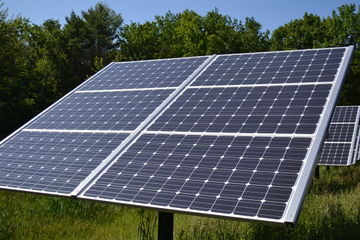Solar collector orientation

Considering the placement and orientation of solar energy collectors is just as important as considering which type of solar panel is best to use in a given situation. Ensuring that solar panels face the correct direction and have an appropriate tilt will help ensure that they produce maximum power as they are exposed to the highest intensity of sunlight for the greatest period of time.[2]
The more sunlight that hits solar panels, the more electricity they are able to generate, saving homeowners more money.
Direction
The general rule for solar panel placement is that when located in the Northern Hemisphere, solar panels should face true south. South is generally a beneficial direction as solar panels will receive direct light throughout the day. However there is a difference between magnetic south and true south that must be considered. Magnetic south is the "south" shown when a compass is used, and this south points to the Earth's south magnetic pole. Solar panels, however, need to face solar or geographic south, which is the direction towards the south pole.[2] If the solar panel is located in the southern hemisphere, the panel should instead face in the direction of true north.
Depending on how solar collectors are being used, it may also be beneficial to have a slight tilt away from due south. For example, it has been argued that solar panels used to provide electricity for a home should face slightly south-west. Although these panels are collecting more energy when they face due south, the problem is they are not making this energy at the hours that it is really needed. If the panels were pointed slightly south-west, in the direction of the setting Sun, this would mean that the panels would produce more energy in the evening, which are the hours when electricity is most needed. Although their total production would be decreased, it would increase the amount of electricity available when it is needed most. In most areas there is enough electricity available from other sources in the morning and midday.[3]
When solar collectors are used for heating and lighting specifically - particularly in the form of fenestration such as windows - it is actually best to have these collectors facing somewhat east. Warming the house for the day means morning sunlight is more needed.[4]
Angle
The angle or tilt of a solar panel is also an important consideration. The angle that a solar panel should be set at is determined by the latitude. Essentially, the closer a solar panel is located to the equator the more the panel should be pointing straight up. The closer the panel is to the poles, the more they should tilt towards the equator.[2] There are several options for determining the angle a solar collector should be set at based on how frequently the angle is changed. Ideally, the panel angle is changed four times a year along with the seasons to best collect sunlight. If this is not an option, however, there are certain angles that can be chosen to ensure maximum sunlight collection at all times during the year.
Fixed Tilt
If the solar panel has a fixed tilt angle and will not be changed during the year, there are some disadvantages. Despite being convenient, there will be less power than if the angle is adjusted. As a general rule, the horizontal tilt for a solar panel that will not be adjusted with the seasons is:[5]
- Location latitude times 0.87, if the latitude is less than 25°
- Location latitude times 0.76 plus 3.1 degrees, if the latitude is between 25° and 50°
For latitudes greater than 50° a special assessment may be needed to determine the optimal positioning of the solar panel.
Twice Yearly Change
Solar panels can also be adjusted twice a year to account for the different winter and summer Sun positions. Generally speaking, the best tilt angle for summer is the solar power latitude, times 0.93, minus 21 degrees. For winter, the tilt should be the latitude, times 0.875, plus 19.2 degrees. It is also important to adjust to these angles on the right days. For the northern hemisphere, the summer adjustment should be made on March 30th while the southern hemisphere adjusts on September 29th. Winter adjustments should be done on September 12th for the northern hemisphere and March 14th in the southern hemisphere.[2]
4-Season Angle Change
Finally, there is an option to change the tilt of a solar panel for each of the four solar seasons. The following adjustments for all four seasons are:[6]
- Summer: The latitude, multiplied by 0.92, and subtract 24.3 degrees. In the northern hemisphere, change for summer on April 18th and on October 18th for the southern hemisphere.
- Spring and Autumn: The latitude, multiplied by 0.98, and subtract 2.3 degrees. In the northern hemisphere, change for spring on March 5th and autumn on August 24th. The dates are September 4th and February 23rd for the southern hemisphere.
- Winter: The latitude, multiplied by 0.89, and add 24 degrees. Change for winter on October 7th for the northern hemisphere and September 4th for the southern hemisphere.
References
- ↑ Wikimedia Commons. (August 11, 2015). Fixed Tilt Solar Panel [Online]. Available: https://upload.wikimedia.org/wikipedia/commons/2/2c/Fixed_Tilt_Solar_panel_at_Canterbury_Municipal_Building_Canterbury_New_Hampshire.jpg
- ↑ 2.0 2.1 2.2 2.3 Dave Llorens. (August 11, 2015). Which direction should solar panels face? [Online]. Available: http://www.solarpowerrocks.com/solar-basics/which-direction-should-solar-panels-face/
- ↑ Matthew L. Wald. (August 11, 2015). How Grid Efficiency Went South [Online]. Available: http://www.nytimes.com/2014/10/08/business/energy-environment/how-grid-efficiency-went-south-.html?_r=1
- ↑ NRCAN. (August 18, 2015). Heating Your Building with Solar Energy [Online]. Available: http://www.nrcan.gc.ca/sites/www.nrcan.gc.ca/files/canmetenergy/files/pubs/SOLAR-HeatingBuildingWithSolarEnergy.pdf
- ↑ Solarpaneltilt.com. (August 11, 2015). Optimum Tilt of Solar Panels [Online]. Available: http://www.solarpaneltilt.com/#other
- ↑ GreenerEnergy. (August 11, 2015). Tilt and Angle Orientation of Solar Panels [Online]. Available: http://greenerenergy.ca/PDFs/Tilt%20and%20Angle%20Orientation%20of%20Solar%20Panels.pdf

